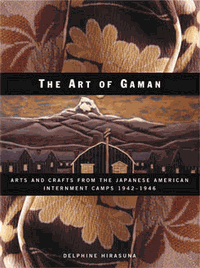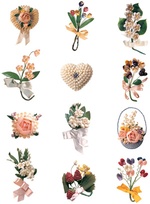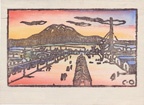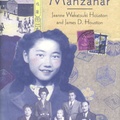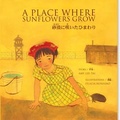Looking through the pages of Delphine Hirasuna’s The Art of Gaman: Arts and Crafts from the Japanese American Internment Camps 1942-1946, one is struck by the beauty and craftsmanship of the selected pieces. However, it is more than just the aesthetic quality that shines through. It is the amazing resourcefulness and resiliency of these individuals who, out of necessity and the first idle time of their lives, created objects both utilitarian and decorative.
Although most often translated as “perseverance,” Hirasuna has elegantly defined “gaman” as “enduring the seemingly unbearable with patience and dignity.” Together, “gaman” and “shikataganai” (it cannot be helped) were the attitudes that helped the Issei endure the difficult and harsh realities of their lives before, during, and after World War II.
In an interview, Hirasuna explained, “The inspiration for the book came from a carved wooden bird pin that I found in an old wooden jewelry box after my mother died in 2000. From the safety pin clasp, I kind of figured that it was made in camp. My friend, Kit Hinrichs, noticed me wearing the pin one day and asked where it came from. When I told him, he commented that it would make a good topic for a book.” Hinrichs is a partner in the international design firm Pentagram. The two have collaborated on a number of books, most recently Long May She Wave which featured his extensive flag collection. He offered to design the book and Terry Heffernan who photographed the artifacts in Long May She Wave offered to photograph it.
With her team in place, Hirasuna then needed to locate items for inclusion in the book. She received help from her uncle and aunt, Bob and Rose Sasaki of Lodi, California. They spread the word in their community that she was looking for items. As a result, a large number of items were from individuals of that area. In addition to pieces located through other personal contacts, she borrowed artifacts from the Japanese American National Museum, the National Japanese American Historical Society of San Francisco, the Japanese American Museum in San Jose, and the Sacramento State University Special Collections Department.
When asked whether it was difficult to find items for the book, she responded, “One challenge I encountered was trying to represent each camp and get a variety of objects. Because most of the people in Lodi were incarcerated in Rohwer, Arkansas, I was getting a lot of carved wooden things. It was harder to find things from Poston and Manzanar because I knew fewer people in Southern California.” Another difficulty in finding a broad variety of objects was that many saw considered their creations as busy work, and so didn’t recognize the value in them or their own artistic skills. In other cases, they were too difficult to transport. As a result, many were left at the camps when they left.
“A lot of stuff was thrown away after the war, but I suspect that there is still a lot out there that is stored and forgotten. So many of the objects were handed over to me in boxes that date back to the 1940s. People stuck them in the back of the garage or shed and never looked for them again.” This lack of recognition for the significance of the pieces continues today. “A few people were a bit sheepish, apologetically saying that I might not think that the item was ‘good enough to be in the book.’ Of course, they were wrong—the thing they invariably had was wonderful.”
“Personally, I suspect I would not have gotten the same cooperation had I tried to write this book 30 years ago. It is the distance of time and the eagerness of Nisei to share something their parents made that gained so much cooperation. That’s the good part. The bad part is that the Nisei who are still active now were teenagers or young children then. When I ask them what they remember of their parents making the object, they can’t recall a thing. My regret is that I haven’t been able to speak to some of the artisans first hand and hear how the object was made and what it represented to them. But with the exception of two artists in the book, the rest of them are gone.”
“I am hoping that Nisei who see this book will recognize the historic value of things made by their parents in camp and save them or pass them on to institutions like JANM that will care for them and preserve them properly. If any Nisei (I say Nisei because the Issei who made nearly all of the items are gone) plan to hand the object down to their children, they need to place a note with the item telling where it was made and by whom. In more than one instance, people told me that they had something and their kids gave it to Goodwill or tossed it out because they saw it as junk. That’s very sad. The artifacts are not only part of history, but they represent the spirit and humanity of the Issei.”
For the author, one of the most rewarding and enlightening aspects of producing the book has been hearing the personal stories. Even now as she talks to groups about the book, they continue to share their stories. She says, “With every story, I feel that a few more pieces of a very complex puzzle fall into place. Still, I know that this is a puzzle that will never be completed. I will never have all the pieces to get a full and accurate picture of what it was like. Each person experienced it a little differently.”
Looking at The Art of Gaman draws one into thinking about the conditions under which these objects were made. The items bear testimony to the human soul’s requirement for beauty—no matter what the daily circumstances might be. These beautiful objects, created from cast-off or salvaged materials, make it poignantly evident that one purpose of art is to raise the soul or to inspire us and lift us above our situation.
Hirasuna heard from a reporter that someone had told her that depression was rampant in the camps. “This person said that when someone was really down, people would band together and bring over something to beautify the person’s barrack—a carving, an embroidered doily, a papier mache floral arrangement. In the stark camp environment, things of beauty sustain the soul, remind people of their humanity. They reclaim their voice, their sense of self, in a place that reduced them to a numbered tag on their lapel, and a prisoner with no rights. Art lifted their spirit. The act of creating gave them something that no guard or government could take away.”
Photographs reprinted with permission from The Art of Gaman: Arts and Crafts from the Japanese American Internment Camps 1942-1946. Copyright © 2005 by Delphine Hirasuna, Ten Speed Press, Berkeley, CA. Photo Credit: Terry Heffernan.
* This article was originally published in the Japanese American National Museum Store online.
© 2006 Japanese American National Museum


